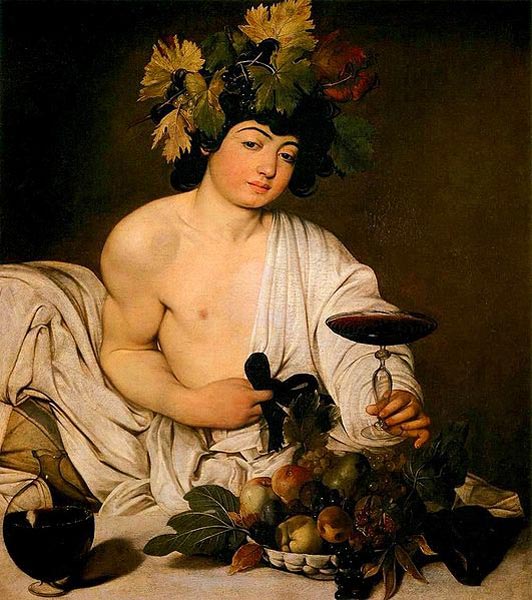| Bacchus | |
|---|---|
 |
|
| Artist | Caravaggio |
| Year | c.1595 |
| Medium | Oil on canvas |
| Location | Uffizi, Florence |
| Dimensions | 37 in × 33 in |
| 95 cm × 85 cm | |
| Famous Paintings by Caravaggio | |
| David with the Head of Goliath | |
| Medusa | |
| Bacchus | |
| Conversion of St. Paul | |
| Ecce Homo | |
| Narcissus | |
| Judith Beheading Holofernes | |
| Supper At Emmaus | |
| Sacrifice of Isaac | |
| Complete Works |
Bacchus by Caravaggio is an oil on canvas painting painted by Michelangelo Merisi da Caravaggio. Completed in about 1595 A.D., it is an example of the Renaissance era’s interest in Classical revival. It was painted during Caravaggio’s stay with his first patron, Cardinal del Monte.
Description
A young, dark-haired man clad only in a loosely draped robe offers an ornate glass goblet of red wine with his left hand. His right grasps a black cord that appears to secure his robe. In front of him is a bowl of fruit; to the viewer’s left is a round carafe of red wine.
Technique
Caravaggio was a young man when he painted this work, and scholars speculate that he may have been the model as well as the artist. He may have painted as a self-portrait directly from a mirror, or he may have used some early form of a camera lucida, a reflecting device that allows the artist to see subject and canvas simultaneously.
While the painting is not strictly chiaroscuro, its pale-skinned main figure highlighted against a darker background with stark shadows foreshadows his later dramatic use of chiaroscuro and tenebrism. Caravaggio further played with light in Bacchus by including reflections. A reflection of Bacchus can be found both in the carafe and in the wine in the goblet in his hand.
Innovation and Symbolism
Caravaggio advanced the realist, humanistic style of painting that the later Renaissance perfected. His Baccus is not portrayed as a perfect saint but rather as a drunken teenager with dirty fingers in front of a bowl of half-rotten fruit. The rotten fruit is thought to be a symbol of the transience of life. The Bacchus figure, portrayed by Caravaggio as a dissolute youth, illustrates the artist’s interest in naturalism.
Bacchus is a fine example of Caravaggio’s early work. Part portrait, part allegory, and part still life, centuries later it still rouses debate and captures the viewer’s imagination.